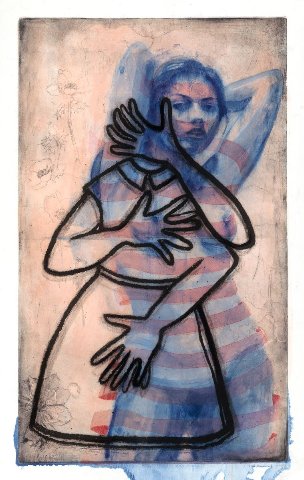Lorie Hamermesh at Gallery Naga
After a 15 Year Hiatus Now Desire/Shame
By: NAGA - Aug 24, 2021
Lorie Hamermesh
Desire/Shame
September 7 - October 2, 2021 at Gallery NAGA
After a nearly 15 year hiatus from art making and exhibiting, Lorie Hamermesh is back in a daring and spectacular fashion at Gallery NAGA for a solo exhibition accompanied by a fully illustrated catalog and essays by fellow Boston artists Carol Daynard and Cameron Barker.
Lorie Hamermesh: Desire/Shame will open to the public on Tuesday, September 7, and a public reception will take place on Friday, September 10 from 6 - 8 pm. An artist walk-through is scheduled for September 18 at 2 pm. Gallery NAGA’s hours are Tuesday - Saturday from 10 am - 5 pm, with no appointment necessary. Masks are required.
Lorie Hamermesh makes monoprints, or an impression made from a surface onto which oil paint has been applied. These prints are never straight forward and instead go through multiple processes, some of which are drypoint, carborundum, chine collé, and watercolor.
Underneath these deeply layered and personal prints lie female figures whose gestures and qualities resonate deeply with Hamermesh. Taken from her own personal experiences and upbringing, as well as notions of the female body as portrayed in history, the images expose to the viewer both the beauty and rawness Hamermesh feels and sees.
In his essay for the catalog, Cameron Barker observes the masterful way in which Hamermesh merges her printmaking and subject matter.
The dichotomy of Desire/Shame resonates with Hamermesh’s monoprint process: where painterly watercolor transfers collide with delicate chine-collé, finely incised drypoint marks, and boldly textured carborundum. In MeToo (1) & (2), a figure in cool blue tones, perhaps deanonymizing the objectified nudes of Yves Klein, is offset by a black carborundum contour in the form of a dress with multiple arms and hands. The direct gaze of the figure imbues power, yet the hands introduce an internal/external struggle between protection and exposure of the body. Hamermesh is not offering answers to trauma, but instead encourages conversation that explores visually, the complex ways trauma is brought to light.
Barker rounds out his observations with a touching portrait of Hamermesh.
Desire and shame: layers that find themselves both separate and unyieldingly pressed together in human experience. Lorie Hamermesh grants the viewer an opportunity to look into these complicated and sometimes painful themes with beauty and a sense of compassion. The work is a reminder that the swinging pendulum of opposing feelings may not have to be feared, but can be investigated and shared with generosity and open arms.


